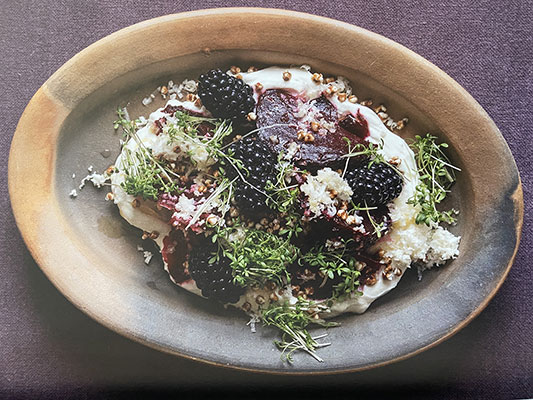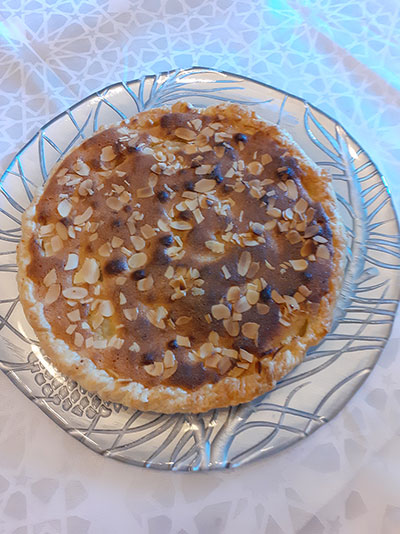Low Tea & Scones
Gillian Perry, United Kingdom
A Passion for Sweets
Sara Levy, Mexico
A Travelling Honey Cake
Nancy Rozenchan, Brazil
Flavors from my childhood
Shulamith Serur de Shrem, Mexico
A Mediterranean Specialty
Haya Molcho, Germany
Our Chef and our Inspiration
Jonathan Touboul, Israel Bonds in France

Low Tea & Scones for Rosh Hashanah!
Gillian Perry
United Kingdom
 During my talks on the social history of afternoon tea, I am often asked to recommend appropriate tea table items for special events. A traditional afternoon tea is considered quintessentially English but is, in fact, enjoyed all over the world. As we are approaching Rosh Hashanah, a busy time of family gatherings at all hours of the day, I am turning my attention to what items would enhance a new year’s tea table.
During my talks on the social history of afternoon tea, I am often asked to recommend appropriate tea table items for special events. A traditional afternoon tea is considered quintessentially English but is, in fact, enjoyed all over the world. As we are approaching Rosh Hashanah, a busy time of family gatherings at all hours of the day, I am turning my attention to what items would enhance a new year’s tea table.
The emphasis is, of course, on our shared wishes for a sweet year ahead. The savoury and delicately crustless afternoon tea sandwiches could extend the sweet theme by the substitution of small bridge rolls. Bridge rolls are mezonot, meaning that they are defined as cake rather than bread (in Orthodox circles they do not require the washing of hands prior to consumption). They are sweeter than bread because the dough is made with fruit juice rather than water. I’d suggest allowing no more than three or four small rolls per person, as there will surely be more indulgences to follow.
It’s now the turn of those little bready beauties, the scones. The first dilemma is pronunciation: Are you a ‘scone as in gone’ or a ‘scone as in bone’ person? Either is correct, and is often divided on geographical lines. And now – and this is real controversy - are you a ‘Cornwall or a Devon’ type of person? In other words: jam first onto your scone, then cream on top (Cornwall) or alternatively cream first and jam on top (Devon)? To add to the festive feel, extra amounts of raisins can be baked into the scones, or the jam’s fruitiness can be enhanced with slices of real red fruits, whether raspberries or strawberries. But please don’t fill yourself up with the scone course!

Thanks to Mary, Queen of Scots’ alleged aversion to cherries, the fashion for cakes topped with slivered almonds started.

Finally, if we happen to be treated to a three-tiered cake stand, on the top tier proudly sits the patisserie. If there are no cake stands, platters are then laid out as the showpiece of the table. For Rosh Hashanah, we can include finger-sized portions of rich, spicy honey cake, whether almond-crusted or not (thanks to Mary, Queen of Scots’ alleged aversion to cherries, the fashion for cakes topped with slivered almonds started) and of course, enticing squares of cinnamon-flavoured apple cake or strudel. The addition of a couple of chocolatey items will also be appreciated.
Finally, very aware of the amount of eating happening throughout the autumn Jewish Holidays (with one notable exception!), afternoon tea should definitely be a low tea, rather than a high tea. As I am at pains to point out to my American family and friends, ‘high tea,’ as they insist on calling a classic afternoon tea, was actually associated with the factory workers and farm labourers, for whom it was their sustaining evening meal, taken at the higher time of the day after their return home from a hard day’s work. ‘Low tea’, on the other hand, was enjoyed by the upper classes at the lower time of the afternoon, 3 pm – 4 pm, and did not have to be fully sustaining, as the aristocracy could look forward to a large dinner in the evening.
And perhaps most importantly, only fine china cups and saucers should adorn afternoon tea. Save the heavy mugs for morning coffee!
Easy as pie’ scone recipe
Ingredients:
450g self-rising flour
1 tsp baking powder
80g caster sugar
Pinch of salt
100g cold butter or margarine – chopped into small pieces
284 ml milk (whatever kind you have in the fridge). Buttermilk works very well.
Turn the oven up to 220C (430F) or Gas Mark 7 (as long as it’s hot!). Pre-heat a baking tray.
Sift the flour, salt and sugar into a largish bowl. Using a light touch, rub the butter or margarine into the flour until it resembles fine breadcrumbs. Can also be quickly blitzed in a food processor.
Gradually add the milk mixture mix with a knife or a metal spoon, as this means you don’t overwork the mixture. Try not to make the mixture too wet. It’s a good idea not to add all the milk at once. You will get a feel for when the dough has the right amount of milk. Not too wet, not too dry! It should all come together in a softish ball.
Flatten the ball gently with your hands on a floured surface. Don’t roll your scone dough too thin, 4 cm is a good depth.
Cut out your scones – be gentle, don’t over work the scones and try not to twist your cutter – just press down firmly and shake the scone out – and if the cutter gets sticky, dip it in the flour bag.
Remove the tray from the oven and sprinkle the hot tray and the scones with flour. Bake for about 10/12 minutes, depending on your oven. Allow to cool and serve with jam and cream.
Recipe by Gillian Perry published in Please Pass the Scones, a Social History of Afternoon Tea by Gillian Perry, Carnegie Publishing, 2022.
Gillian also gives popular talks on the topic for charities, social groups and private celebrations.

My Grandmother’s Legacy: A Passion for Sweets
Sara Levy
Chef and creative director of Timbal de Azucar, Mexico
 My name is Sara Levy and I'm proud to be a chef and the creative director of Timbal de Azucar. At our company, we are passionately dedicated to the creation of exquisite sweets and desserts, handmade artisanal chocolates, and spicy gourmet products, all made from unique recipes that we have developed throughout the years.
My name is Sara Levy and I'm proud to be a chef and the creative director of Timbal de Azucar. At our company, we are passionately dedicated to the creation of exquisite sweets and desserts, handmade artisanal chocolates, and spicy gourmet products, all made from unique recipes that we have developed throughout the years.
My passion for the creation of confectionaries such as chocolates, candies, sweets, spicy fruit items, etc. has been a constant in my life since I was very little. I remember when I used to join my grandma Sara to prepare delicious sweets made of apricots, almonds, and pistachios for Rosh Hashanah. Every one of her recipes turned into a legacy that has a direct effect on the celebration of my clients’ events

Our food has been a bridge between the past and the present, symbolizing the
continuity of our traditions.

For me, every kitchen and every recipe tells a story. Jewish cuisine reveals the migration of people and their diverse worlds throughout time. This is why I think our food has been a bridge between the past and the present, symbolizing the continuity of our traditions.
Cooking is a passionate art, the language of the soul that joins people and accompanies them throughout their lives. My goal is to transmit emotions and sensations in every bite, making each experience unique and meaningful.
Sweet Apricot Paste Treat (Amardeen)
Ingredients:
1kg dried apricots (preferably Californian apricots, tart-flavored)
1 cup warm water
½ cup confectionary sugar
1 tsp lemon salt (If you don’t have lemon salt, combine sea salt with a bit of lemon zest)
½ cup unsalted, ground, peeled pistachios
Add the apricots and warm water to a large bowl and soak for 2-3 hours to soften. Once softened, add them to a food processor fitted with a metal blade, and blend until you have a smooth paste. Slowly add the sugar and the lemon salt while still blending. Once combined, fold in the pistachios. Place the mixture into a deep pan and flatten out. Cover with a dish towel, be careful not to let the fabric touch the paste, and let dry at room temperature for at least 2 days.

Photos of exquisite desserts and sweets courtesy of Timbal de Azucar.

A Travelling Honey Cake for a Sweet New Year
Nancy Rozenchan
São Paulo – Brazil
 Making honey cake, the traditional honig-leikech for Rosh Hashanah, is something very special to me. I didn't inherit my mother's recipe; I discovered and adapted it from the internet. My mom used to say that her recipe wasn't very good, and I don't remember her making it every year.
Making honey cake, the traditional honig-leikech for Rosh Hashanah, is something very special to me. I didn't inherit my mother's recipe; I discovered and adapted it from the internet. My mom used to say that her recipe wasn't very good, and I don't remember her making it every year.
I don't remember when and why I decided to try this recipe. Decades ago, effusive wishes were exchanged by telephone before the holidays, since most of the family lives in Rio and we live in Sao Paulo. I made the cake; it was very tasty. As the years went by, I decided to share the wishes for a sweet year with my cousins and a few other people by sending my cake. It's not the prettiest, but it's undoubtedly one of the tastiest. My cousins share theirs with their offspring and family ties are thus resumed.

I didn't inherit my mother's recipe; I discovered and adapted it from the internet.

It all starts with the grocery list (let me see: how many jars of honey did I buy last year? It's noted on the last page of the old diary), then the disposable store list and the stationery store list. Yes, packaging cake for shipping takes a little skill... and scripting for the driver who does this every year. Is he still a driver? Will he be available? The driver also receives a cake, I love to share the spirit of the holiday.
We no longer get together in large groups to celebrate, but the call from each family member confirming that they received —and maybe tasted the cake— helps to maintain the same spirit of wishing everyone a good year, with lots of health and joy.
Honey Cake
Ingredients:
3 ½ cup wheat flour (with yeast)
1 tsp baking soda
½ tsp salt
½ tsp cloves
4 tsp cinnamon
1 cup oil
1 cup honey (I usually heat it in the microwave for 10 seconds)
½ cup brown sugar (if not, add more powdered sugar)
1 ½ cup granulated sugar
3 eggs
A few drops of vanilla
1 cup lukewarm strong coffee (or strong tea)
¾ cup orange juice (if cold, heat for 5-6 seconds)
Add all ingredients to a stand mixer bowl and mix just until combined, the batter is not supposed to be "airy." Grease the cake pan. Bake for about 1 hour at 180 C or 350 F degrees.

Flavors from my childhood
Shulamith Serur de Shrem
Mexico
 Ever since I was a little girl, I’ve had the privilege of enjoying the smell and the flavors of a warm home where you could be surrounded by love, live with joy, and eat in an environment full of sweetness.
Ever since I was a little girl, I’ve had the privilege of enjoying the smell and the flavors of a warm home where you could be surrounded by love, live with joy, and eat in an environment full of sweetness.
When growing up with my siblings, Sally, Pepe, and Cynthia, my parents, David Serur Edid z”l and Jennie Cababie de Serur, transmitted their love and work for our land, Israel. They also taught us their love for Mexico, its culture, special places, people, its marvelous music (masterfully sung by my mother), and its delicious food. Among these are the traditional Mexican candies made from pecans, pine nuts, coconuts, almonds, and pistachios, but above all, Cajeta (a thick caramel sauce).
When I travel back in time to my childhood, I have my best and sweetest memories of the aroma from the oven where they browned the bolillo con cajeta (a typical Mexican bread with a type of caramel), and every Sunday during the family breakfast we used to share this typical Mexican delicacy with joy.

Our main goal is to keep alive the culinary influences that our Sephardic ancestors brought to our beloved Mexico more than five hundred years ago.

For me, cooking throughout my life reflects my story, which is a celebration of my family legacy. It is the best way to share my love for my family—my husband, my daughters and son, and my granddaughters and grandsons. Cooking has served as a tool in helping the community organizations which I head as president.
Today I feel blessed to be the president of the Asociacion de Amigos de la Fundacion HispanoJudia en Mexico (Association of Friends of the Hispanic Jewish Foundation in Mexico), in which part of our main goal is to keep alive the culinary influences that our Sephardic ancestors brought to our beloved Mexico more than five hundred years ago. Ingredients that in their day marked history now endure through time. Our ancestors contributed to Mexico a wide variety of flavors, such as olives, olive oil, almonds, eggplant, potatoes, and fermented wheat.
Another example of this is saffron, which was commercialized as a valuable spice and was exchanged for gold.
Cajeta: a thick caramel sauce considered a traditional Mexican ingredient used for confectionary treats made from goats’ milk, brown sugar, and cinnamon. Its name comes from cylinders made of wood known as “cajetes” (unglazed casseroles), because that is how they started commercializing it.
Bolillo - bread roll: undoubtedly, the bolillo is one of the most essential elements in the Mexican kitchen. Mexican gastronomy wouldn’t make sense without this peculiar type of bread, used in a large number of dishes.
Mousse de cajeta
Ingredients:
400 g cajeta envinada (Cajeta which is ‘spiked’ with added spirits)
5 eggs, separated
2 Tbsp of milk
1 Tbsp of sugar
3 palanquetas ajonjoli (smashed sesame bars— a Mexican sweet)
Melt the cajeta in the double boiler and leave it until you get a light consistency; add the milk and the yolks one by one and mix with a wooden spoon until all is incorporated. Remove from the heat, pour into a deep container and let it cool. In a bowl, whip the egg whites with the sugar and smoothly cover the cajeta until it all turns the same color. Refrigerate for a minimum of 5 hours and serve in tall glasses. Decorate with the smashed sesame bars.
Makes 10 servings.
Pine nuts sweet
Ingredients:
500 g pine nuts
200 g condensed milk
½ L. of milk
1/8 tsp of pine nuts essence
Bring to a boil both types of milk, and at boiling point, add the pine nuts and continue boiling for another 20 minutes until it thickens.
Pour into a deep glass dish or small glasses. Decorate with pine nuts.
Wishing you a Shana Tova full of sweetness and love.

A Mediterranean Specialty for Rosh Hashanah
Haya Molcho
Germany
 Haya Molcho was born in Tel Aviv and moved with her parents to Germany at the age of nine. After graduating from school, she studied psychology. Since 1978 she has been married to Samy Molcho, with whom she traveled through India, Japan, China, Morocco, and many other countries due to his work before she settled with him in Vienna. They have four sons. Haya, who has been cooking since she was a child, has only been in the catering business since 2003, when a neighbor asked her to take over the catering for one of her parties. In 2009, she opened her first restaurant under her brand NENI (an acronym from the first letters of the names of her four sons: Nuriel, Elior, Nadiv, Ilan) on Vienna's Naschmarkt. The name reflects the Molchos’s philosophy, as the family is an integral part of their life and the whole family and many friends have always eaten together at a large table. In addition to the Naschmarkt location, Tel Aviv Beach, and on the Vienna Danube Canal, she and her sons now run restaurants under her brand in Berlin, Hamburg, Munich, Zurich, Mallorca, Cologne, Paris, and Amsterdam, in which the dishes focus on Middle Eastern recipes, especially Israeli cuisine. Under “NENI at the Table,” twenty-five different products including hummus, baba ghanoush and falafel are sold in 1.600 supermarkets and NENI maintains a Europe-wide cooperation with the hotel chain 25 Hours.
Haya Molcho was born in Tel Aviv and moved with her parents to Germany at the age of nine. After graduating from school, she studied psychology. Since 1978 she has been married to Samy Molcho, with whom she traveled through India, Japan, China, Morocco, and many other countries due to his work before she settled with him in Vienna. They have four sons. Haya, who has been cooking since she was a child, has only been in the catering business since 2003, when a neighbor asked her to take over the catering for one of her parties. In 2009, she opened her first restaurant under her brand NENI (an acronym from the first letters of the names of her four sons: Nuriel, Elior, Nadiv, Ilan) on Vienna's Naschmarkt. The name reflects the Molchos’s philosophy, as the family is an integral part of their life and the whole family and many friends have always eaten together at a large table. In addition to the Naschmarkt location, Tel Aviv Beach, and on the Vienna Danube Canal, she and her sons now run restaurants under her brand in Berlin, Hamburg, Munich, Zurich, Mallorca, Cologne, Paris, and Amsterdam, in which the dishes focus on Middle Eastern recipes, especially Israeli cuisine. Under “NENI at the Table,” twenty-five different products including hummus, baba ghanoush and falafel are sold in 1.600 supermarkets and NENI maintains a Europe-wide cooperation with the hotel chain 25 Hours.
Oven Cooked Beets with Labneh
Ingredients:
 Beets:
Beets:
1kg coarse salt (for salt bed)
2.0-2.40 kg beets
80g olive oil
2 tsp lime juice
2 tsp red wine vinegar
Cumin, ground
For Serving:
140g buckwheat
100g labneh
Fresh horseradish
160g blackberries
1.5 Tbsp apple cider vinegar
100g olive oil
Chervil/French parsley
Cress or Watercress
lemon
Preheat the oven to 200C or 400F top/bottom heat.
Sprinkle coarse salt on a baking sheet. Place unpeeled beets on top. Cook in the oven for about 1 hour until tender. Peel and cut into pieces, and -marinate with olive oil, lime juice, red wine vinegar and cumin.
Fry the buckwheat in oil heated to 180C degrees or 350 F until golden brown. Drain on kitchen paper.
Spread the labneh on the plates with a spoon.
Arrange the beetroot pieces on the labneh and grate the horseradish over them. Mix the blackberries with the apple cider vinegar and spread over the top. Garnish with buckwheat, chervil and cress, drizzle with olive oil and lemon juice. Serves 4.
Photos courtesy of NENI

Our Chef and our Inspiration
Jonathan Touboul
Executive Director, Israel Bonds in France and French Speaking Countries

Lisette has been the pillar of Israel Bonds in France for twenty-four years.
In addition to her professionalism and her ability to handle all kinds of situations, she is, we discovered, a person who lives by giving and sharing, and for whom these qualities come through in the art of cooking, which she cultivates with great talent. And she is recognized in her family and community as a great specialist in Moroccan cuisine.
Indeed, for Lisette, the meticulousness with which she makes pastries, among other things, is strongly linked to the attention she pays to the person who will taste them afterwards.
I personally cannot resist Lisette's sweet orange jam, made from a variety of orange found only in Spain, and which very few people in Paris still know how to make.
Lisette, thank you for sharing your many talents with us, and for this delicious recipe of a pastry that was a favorite of my father’s z”l.
And to paraphrase what was said by a colleague at your retirement party, “you're the epitome of a lady!”

A Sweet Moroccan Treat for a Sweet New Year
Lisette Bengio
France
 Dear Friends of Bonds,
Dear Friends of Bonds,
My passion for Moroccan cuisine is part of my heritage. The Moroccan Jewish cuisine is rich in both savory and sweet flavors. It is a refined gastronomy that places great emphasis on form and taste, whether for festive dishes or everyday ones. In the Mellah, the Jewish quarter, the culinary inspiration of Moroccan Jewish cuisine was influenced by Moroccan and Andalusian traditions.
Indeed, you were my colleagues but today you are my Friends! So, I'm delighted to send you this recipe for Amandine aux Poires tart, delicious and crunchy, and easy to make! It goes well with coffee or tea after lunch on Shabbat days, and especially during the holidays in the month of Tishrei.
And as the sweetness of these pastries reinforces the conviviality of sharing a meal,
I wanted to share with you this recipe as a sign of sweetness for the year ahead.
I can't resist telling you how much I've missed you since I retired. And above all, how proud I am to have contributed my small share of work for Israel Bonds for nearly twenty-four years, and how much satisfaction I've also received from all the wonderful people I've met there. Thank you!!!
I wish you all Shanah Tova. May 5784 filled with joy and sharing!
Tarte amandine aux poires
Ingredients:
 1 roll puff pastry
1 roll puff pastry
1 large tin of pears in syrup
Cream:
100g almond powder (finely ground almond)
60g castor sugar
2 whole eggs,
75g margarine,
1 Tbsp rum (optional).
To assemble the tart, spread the puff pastry in a tart tin, and arrange the pears over top in strips. Put aside.
In a bowl, add the margarine and sugar, and cream until smooth. Add the almond powder, eggs, and rum if using, and mix well.
Pour the cream over the prepared tart. Top with slivered almonds and bake at 200C (400F) or Gas mark
7 for 20 to 25 minutes.

